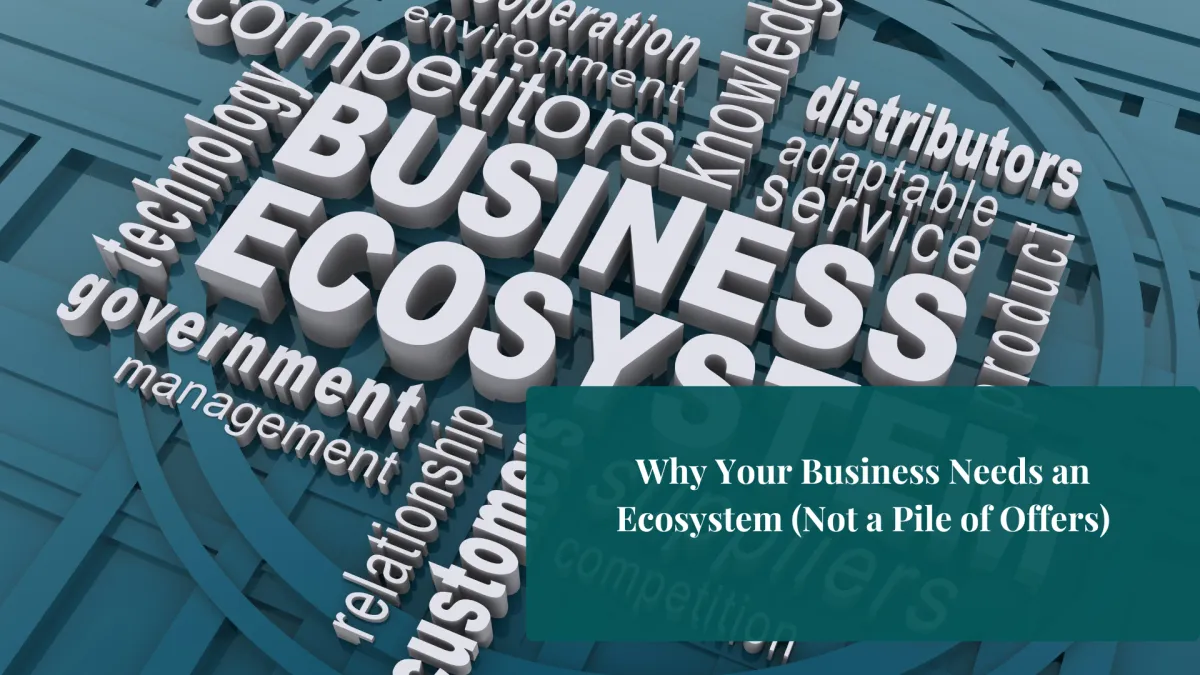
Why Your Business Needs an Ecosystem (Not a Pile of Offers)
Why Your Business Needs an Ecosystem (Not a Pile of Offers)
If your business feels like a cupboard stuffed with half-used jars and mismatched tins, you’re not alone. Most entrepreneurs create one thing at a time — a course here, a challenge there, maybe a group programme when they feel bold. Each new offer feels like progress, but without strategy, what you’ve actually built is clutter, not a client journey.
That’s the problem with what I call offer soup. It looks busy, but it isn’t nourishing.
In the premium market, this creates confusion. Clients can’t see where they belong, what comes next, or why they should stay with you long term. The result? Drop-offs, disengagement, and a business that constantly needs fresh leads just to survive.
What’s the alternative? A business ecosystem: a structure where every offer has a purpose, a place, and a natural next step.
What is a business ecosystem?
Think of an ecosystem as a landscape rather than a menu. Each element connects to the others, creating flow and balance. New clients can enter at different points, but wherever they start, there’s an intentional path forward.
For premium clients, this matters even more. They’re not looking for random workshops or endless mini-courses. They want:
Clarity about where they fit
Progression that feels curated and intentional
Confidence that you’re building something bigger than a collection of offers
The dangers of “offer soup”
Offer soup isn’t just untidy, it actively works against you. Here’s why:
It dilutes your authority
When you’ve got dozens of small, scattered offers, your expertise looks fragmented. Instead of being known for one powerful transformation, you look like you’re dabbling in everything.It exhausts you and your audience
Every new product means new marketing, new funnels, new messaging. You end up stretched thin, while clients feel overwhelmed by too many choices and unsure where to start.It leaves no room for growth
Without a premium layer (your flagship or high-ticket programme) clients hit a ceiling. They can’t step up, so they step away.It breaks trust
When there’s no flow between your offers, clients feel lost. If they can’t see the bigger vision, they won’t invest further. Instead of compounding, your results leak out.
Designing an ecosystem instead
A strong ecosystem usually has three layers:
Entry points – How people first meet you: free resources, a workshop, or an accessible course.
The bridge – Offers that deepen the relationship: group programmes, memberships, or mid-tier experiences.
The flagship – Your high-ticket, premium layer that anchors your brand and showcases the best of your expertise.
Notice this isn’t about creating more offers. It’s about creating fewer, better-connected ones.
Why ecosystems scale (and soup doesn’t)
When your business is built as an ecosystem, you:
✔ Keep clients longer (because they know where to go next)
✔ Increase lifetime value without constantly chasing new leads
✔ Position yourself as a premium authority who thinks strategically, not just tactically
And that’s what transforms a business from scattered to scalable.
👉 I go deeper into this in Episode 2 of my VIP podcast: Building the Ecosystem: How I Layered My Offers. Click the link in my bio to register.
